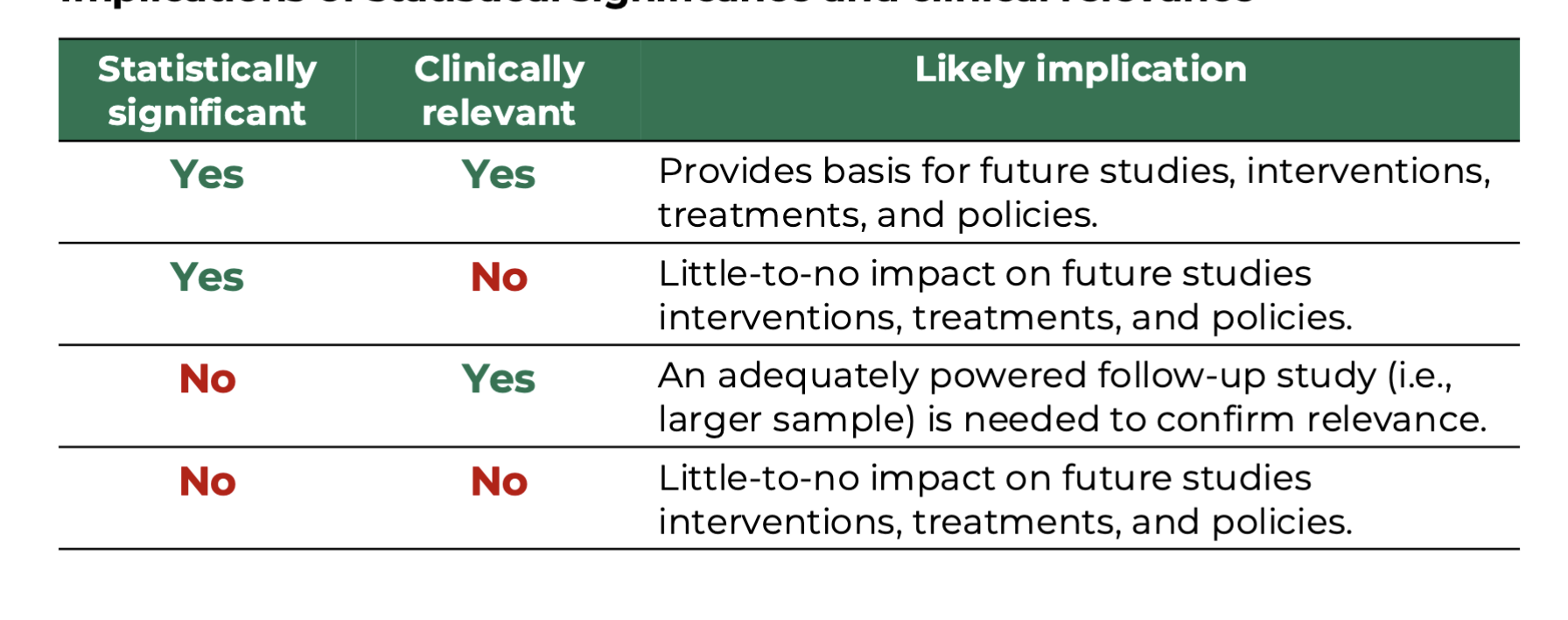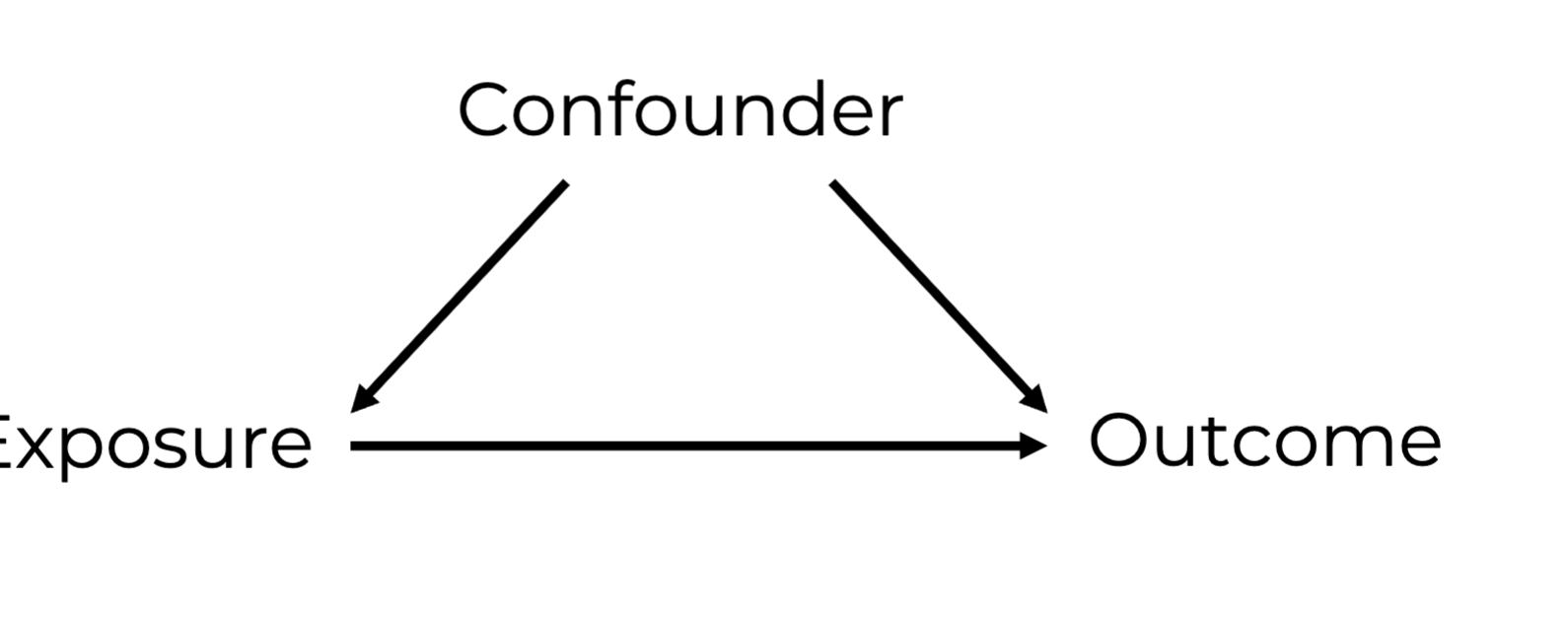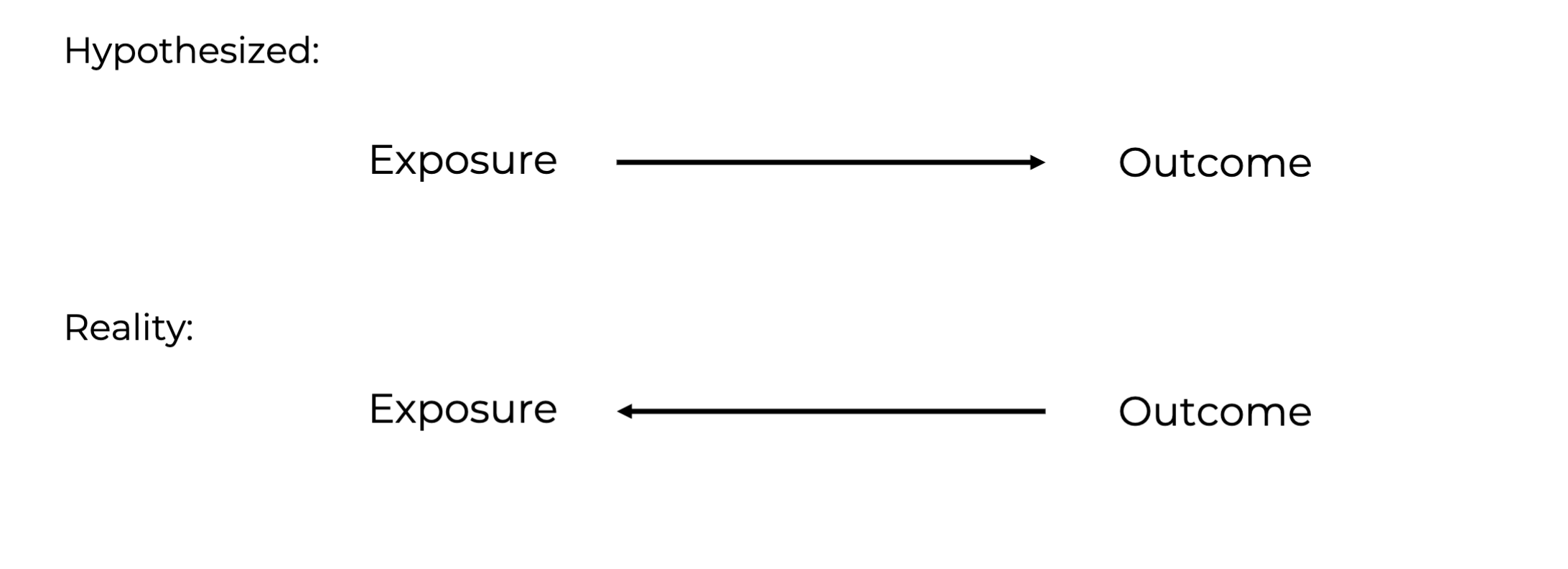Epidemiology Methods I Exam #2
1/89
There's no tags or description
Looks like no tags are added yet.
Name | Mastery | Learn | Test | Matching | Spaced |
|---|
No study sessions yet.
90 Terms
When do we conclude that an exposure and an outcome are associated?
If mean/risk/prevalence difference not equal to 0.
If risk/prevalence/odds ratio not equal to 1.
Above holds only in the absence of error.
Error
The extent to which an effect estimate deviates from the truth.
Two sources of error:
systematic error
random error
Systemic error
caused by flaws in the research methodology
Sources:
unmeasured confounders
Measurement error
non-random sampling.
Consequences: bias in the effect estimates.
Random error
caused by chance variations
most important source is sampling variation.
Consequence: lower precision of effect estimates (but no bias)
Sampling variation
The variation in a measure of occurrence or association across random samples from the same source population.
Caused by the at random selection of individuals from the source population.
Random selection and sampling variation
Every individual in the source population has the same probability of being selected for the study participation.
However, in a single study, individuals with certain characteristics may be oversampled by chance.
Random sampling impacts
Causes variation in estimates of ocurence and association.
The estimates vary around the true occurrence or association.
The average estimate across many samples will approximate the true occurence or association.
Standard error
Quantifies the variability in the sampling distribution.
They are used to calculate p-values and confidence intervals for effect estimates.
is a statistical measure that captures the variability in an effect estimate across many hypothetical samples.
Standard error helps us determine the precision of an effect estimate.
Sampling distribution of ratios
Typically right skewed.
Normal sampling distribution
standard error only have a relevant interpretation.
The natural logarithm (Ln) scale for ratios
Range and distribution before transformation: null effect=1
Range and distribution after transformation: null effect=0
Hypothesis testing
The goal of research is determining if there is an exposure-outcome association
Random sampling variation makes it impossible to determine if the hypothesis holds based on the effect estimate only.
Test hypothesis
the value which we compare the observed effect estimate.
Can be any value. but typically we use the null hypothesis.
Null value=0
Risk/prevalence difference
Mean difference
Ln (risk/prevalence ratio)
Ln (odds ratio)
Null value=1
Risk/prevalence ratio
Odds Ratio
P-value
The probability of observing the effect estimate if the test (null) hypothesis is true.
is determined using the test statistic which helps us determine the location of the effect estimate in a normal sampling distribution.
An estimate is statistically different from the test hypothesis if the P-value is <0.05.
Test Statistics
Tells us how many standard deviations the test hypothesis the observed effect estimate is.
Computed using:
-the effect estimate
-the test hypothesis
-the standard error
Statistical significance
Tells us whether there is mathematically meaningful difference in the outcome between the two compared groups.
is not equal to clinical relevance.
Typically a probability of 5% is used as the cut off.
Effect estimates are considered statistically significant when the P-value<0.05.
Alternative hypothesis: there is an association.
Hypothesis testing limitations
It relies on the strong assumption: we can only reject the null hypothesis if the effect estimate is completely unbiased.
P<0.05 does not say anything about the clinical relevance of an effect estimate.
Confidence intervals formula

Confidence interval width
The higher the confidence level, the wider the confidence interval.
Type I error
rejecting the H0 when H0 is true.
falsley concluding there is an association.
If the effect estimate is unbiased then the probability of making a chance finding equals alpha.
Type II error
failing to reject the H0 when Ha is true.
We falsely conclude there is no association.
Happens when the statistical power is too low to detect a statistically significant association (lack of power)
Statistical power depends on:
the sample size
alpha
the size of the true effect
Power
is the probability that we detect an association when in reality there is an association.
1-Type II error
Power Analysis
The sample size needed to detect a specific effect size given a specific alpha level and the power level.
The minimum effect size that can be detected given a specific level of alpha, power, and sample size.
Clinical relevance
pertains to whether there is clinically/practically meaningful difference in the outcome between the two groups.
-Depends on the size of the effect estimate.
-is context dependent
continuous outcomes: is the mean difference representing a relevant increase/decrease in the outcome.
Binary outcomes: evaluation of the effect size in combination with the background risk; relevant increase/decrease in outcome occurrence.
Statistical significance depends on
The power to detect an effect estimate that is different from the null variable.
Power can be somewhat increased by researchers increasing sample size, increasing alpha.
As power increases more likely to find statistically significant effect estimates.

Implications of statistical significance and clinical relevance
Fundamental problem of casual inference
It is impossible to observe both potential outcomes for the same individual for the same individual over the same time period.
Solution: compare average potential outcomes.
Casual effect
Difference between the ratio of the two average potential outcomes.
Casual assumptions
Exchangeability
Consistency
Positivity
Exchangeability assumption
On average the exposed group and unexposed group are exchangeable in all aspects other than the exposure.
The only characteristic that differs across the two groups is the exposure.
If it holds then we would get the same estimates for E[Y(x)] and E[Y(x*)]
if (hypothetically) we were able to exchange the exposure across the two groups.
Violation of exchangeability
The two differ in aspects other than the exposure and the aspects in which the groups differ also affect the outcome.
Exchangeability and Confounders
Means that there cannot be any unmeasured confounders of the exposure outcome association.
is violated when the distribution of confounders differs across the two exposure groups.
When violated the effect estimate will be biased.
Solutions to the violation of Exchangeability
Randomization
Restriction
Matching
Stratification by confounders
Consistency assumption
The observed outcome for an individual is equal to the potential outcome when the exposure is set to the observed exposure value.
Typically holds in experimental studies where E[Y(x)] and E[Y(x*)] are obtained by randomizing individuals to well defined intervention and control conditions.
Consistency in RCTs
A well defined intervention condition: every person in the intervention condition receives the exact same intervention.
A well defined control condition: every person in the control condition recieves the exact same control.
There is one way in which individuals qualify as exposed/not exposed to vitamin D.
Violations of consistency assumption
The observed outcome for an individual is not equal to the potential outcome when the exposure is set to the observed exposure value.
Violated when two conditions hold.
There is various ways in which an individual qualifies as (not) exposed.
The exposure association outcome differs across the types of exposure.
Solution to the violations of consistency
Use a more precise definition of the exposure values of interest.
But don’t take too far because definitions come at the cost of generalizability.
Positivity assumption
When defining casual effects based on potential outcomes, we essentially assume that one individual (with all their background characteristics) has a positive probability of taking on both exposure values.
Holds when all probabilities are nonzero.
Violation of Positivity
The probability to observe an exposure level of interest based on a specific combination of confounder values equal to zero.
Solutions to violations in positivity
When one or more probability is zero we cannot make comparisons based on that combination of confounder values.
Solution is to restrict the comparisons to combinations of confounder values for which the probabilities of observing x and x* are both nonzero.
For observing drinking and pregnant women it would be beneficial to restrict the analysis to only women 21 years or older.
Directed Acyclic graphs
DAGs are graphs used to visualize the associations between variables. DAGs are informed by subject matter knowledge regarding the associations among the variables of interest.
DAGs and the Research Process
DAGs can help guide data collection and statistical analyses.
Ideally DAGs are developed at the start of the study
Identify confounders that we need to collect data on.
Identify mediators that we may want to collect data on.
identify potential sources of selection bias.
Basic Features of DAGs
Directed paths- lines with one arrowhead shows that the exposure precedes the outcome and the exposure affects the outcome.
The absence of an arrow conveys that the exposure does not affect the outcome.
Acyclic- none of the paths form a closed loop
Reciprocal effects in DAGs
A reciprocal effect means that the exposure affects the outcome and that the outcome in turn affects the exposure.
Third variables
the two focal variables are exposure and outcome but third variables such as colliders, mediators, and confounders can be present.
Confounder
Affect the exposure and the outcome.
A change in the confounder leads to a change in the exposure and the outcome.
Create an open backdoor path between exposure and outcome.
If we leave backdoor path open then there will be confounding bias.

Confounding bias
-The exposure-outcome effect estimates will be larger or smaller than the true size of the exposure-outcome effect.
-The exposure-outcome effect estimate will be nonzero while in truth the exposure-outcome effect is zero.
Mediator
-Affected by the exposure and effects the outcome.
-is on the casual pathway from the exposure to the outcome.
This structure created by a mediator in a DAG is called a “chain”
Changes in the exposure lead to changes in the mediator, and changes in the mediator lead to changes in the outcome. Mechanisms through which the exposure affects the outcome.

Mediators can be used to decompose
the total exposure outcome effect into
An indirect effect through the mediator
A direct effect not through the mediator.
Indirect and Direct pathway Mediator
Indirect effect: the effect of the exposure on the outcome through the mediator
Direct effect: the effect of the exposure on the outcome not through the mediator.
Overadjustment bias
In and of themselves mediators do not bias the exposure outcome effect estimate.
When adjusted in statistical analyses mediators cause “overadjustment bias”
After adjustment for a mediator, the exposure-outcome effect estimate represents the direct effect rather than the total effect.
Mediation analysis
A method for estimating direct and indirect effects with corresponding confidence intervals.
It is increasing used in epidemiology to better understand why exposures and outcomes are associated.
Collider
Affected by the exposure and affected by the outcome
is a common cause of the exposure and outcome.
Change in both the exposure and outcome lead to changes in the collider
a consequence of both the exposure and outcome.

Collider Bias
Colliders do not bias nor explain the exposure-outcome effect.
However colliders can bias the exposure-outcome effect estimates when
Selection into the study is restricted to certain collider variables.
Adjustment is made for colliders in statistical analyses.
Analyses are stratified by the collider.
Reverse causation
The hypothesized exposure is in truth consequence of the hypothesized outcome.
can occur in most study designs but cross-sectional study designs are especially prone to reverse causation.

Sufficient cause framework
conceptualizes causation as a collection of multiple causes of outcomes.
A collection of component causes that when all present in one individual causes the outcome in the individual.
Component causes
single causes of outcome.
Rothman’s sufficient component cause model
sufficient cause represents mechanisms that lead to occurence of the outcome.
Causal Pies
Sufficient causes are visualized using pie charts.
Each pie chart represents a sufficient cause and each slice within the pie chart represents a component cause.
Confounding bias is present
The effect estimate will be larger, smaller, of opposite direction, or falsely nonull compared to the true effect.
True exposure-outcome not equal to null value
The exposure outcome estimate will be larger, smaller, or of opposite sign compared to the true exposure outcome effect.
Overestimation due to confounding
When the exposure outcome effect estimate is larger than the true exposure-outcome effect.
Also called bias away from the null.
Occurs when the combined influence of the confounder exposure and confounder effect is the same in direction as the true exposure outcome effect.
Underestimation due to confounding
when exposure outcome effect is smaller than the true exposure outcome effect.
also called bias towards the null
Qualitative confounding
When the exposure outcome effect estimate is in the opposite direction of the true exposure outcome effect.
Nonnull
If the true exposure outcome effect= the null value
Marginal effect estimate
The effect estimate applies to the whole study population.
Conditional effect estimate
The effect estimate applies only to a subset of individuals with specific confounder values.
Design stages to minimize confounding
Randomization
Restriction
Matching
Randomization
Random assignment to the intervention group or control group
The intervention and control group will be exchangeable in all apsects other than the intervention/control condition.
Randomization strengths
Targets both known and unknown confounders because in expectation any factors other than exposure will be equally distributed across the two groups.
Works for confounders on any measurement scale.
Randomization limitations
works in expectation due to sampling variability confounders may still be unequally distributed across groups in any one study.
Protocol violations and drop outs might result in unequal distributions of confounders across the intervention and control group.
It is not ethical to randomize individuals to harmful exposures.
Restriction
Restriction of the study population to one specific level of the confounder.
It eliminates the variation in the confounder, so within the restricted sample it no longer effects the exposure and outcome.
Results in conditional effect estimates.
Restriction strengths
Most effective way to prevent confounding by a known confounder.
Restriction limiations
Does not prevent confounding by unknown confounders.
Reduces generalizability of the findings.
Only works if there is truly no variation in the confounder in the restricted sample.
May not be feasible when there are many confounders and or continuous confounders.
Matching
Compared groups are selected in a way that ensures the same distribution of confounders across groups.
Cohort studies: comparison group is selected in such that the distribution of the confounders matches the exposed group.
Case control studies: controls are selected in such that the distribution of the confounders matches that of the groups of cases.
Types of matching
Pair matching
Frequency matching
Pair matching
One to one individual matching based on potential confounders
For every exposed individual with certain combination of confounder values we include an unexposed individual (or controls) with the same combination of confounder values.
This ensures that distribution of confounder values is the same across exposure groups.
Frequency matching
Selection of groups in such a way that the distribution of confounders is the same across the two groups.
In each exposure group (or cases/controls) a similar proportion of individuals is included with certain confounder values.
Matching strengths
can increase efficiency and power in certain situations.
Matching limitations
Does not prevent confounding by unknown confounder.
May not be feasible and reduce generalizability when there are many confounders and or continuous variable confounders.
one on one matching we may not always be able to find a match.
Limitations of design stage methods to minimize confounding
It is not always feasible to apply design stage methods eg:
The exposure is harmful, so randomization is not possible
Restriction or matching is not feasible because there are too many confounders or continuous confounders.
Randomization or matching failed
Data was not collected with your specific study in mind.
Marginal effect estimate
The effect estimate applies to the whole study population.
Conditional effect estimate
The effect estimate applies only to a subset of individuals with specific confounder values.
Stratification
Perform the analyses separately for different strata of the confounder variable(s).
Results in conditional effect estimates the effect estimate applies only to individuals in that confounder stratum.
Mantel Haenszel methods
Recombine the effect estimates after stratification.
Inverse probability weighting
IPW provides weighted averages of stratum specific effect estimates.
Gives more weight to strata that have a larger number of participants in it.
Individuals are weighted by their inverse of the probability of their exposure value.
Creates a psuedo population in which there are no confounder exposure association.